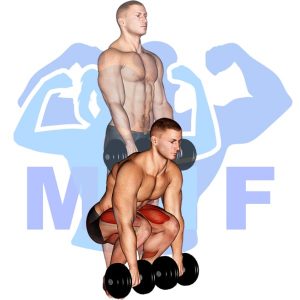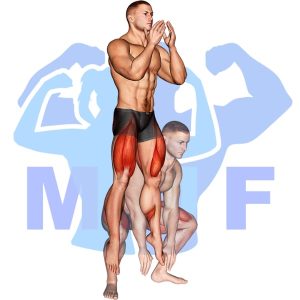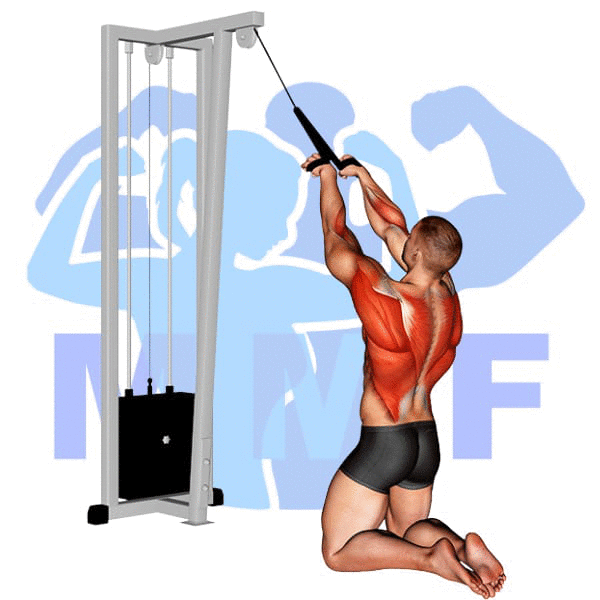If you’re an athlete, fitness enthusiast, or just someone trying to stay active and healthy, you’ve probably experienced lower back pain at some point. The culprit could be a variety of things, from poor form during exercise to bad posture at work. But one effective method for alleviating lower back pain, especially when caused by poor form during exercise, is the lever reverse hyperextension. This exercises targets the muscles in the lower back while also engaging the glutes, hamstrings, and core. In this blog post, we’ll explain the proper technique for performing the lever reverse hyperextension and how it can help alleviate lower back pain caused by exercise.
Lever Reverse Hyperextension (Machine) Summary
- Primary Muscles: Gluteus Maximus
- Secondary Muscles: Hamstrings
- Equipment: Reverse Hyperextension Machine
- Mechanics Type: Isolated
- Force: Push
- Utility: Auxiliary

Lever Reverse Hyperextension (Machine) Instructions
- Position yourself lying on the lever machine with your hips and torso on the pad.
- Grasp the handles at the side of the machine with your hands.
- Push your hips up off of the pad while keeping your legs straight.
- Lower your hips back to the pad while keeping your legs straight.
- Repeat for desired number of repetitions.
Video Tutorial
Lever Reverse Hyperextension (Machine) Muscles
Target (Agonist)
Synergists
Dynamic Stabilizers
- None
Stabilizers
Antagonist Stabilizers

Benefits of Lever Reverse Hyperextension (Machine)
The Lever Reverse Hyperextension (Machine) is an excellent exercise for strengthening the gluteus maximus muscle. This exercise engages the glutes in a dynamic motion and allows for a greater range of motion than traditional exercises like squats or deadlifts. It also helps to increase hip mobility and flexibility, which can help reduce the risk of injury. Additionally, this exercise works the glutes through a full range of motion, allowing for maximum muscle stimulation and improved muscle strength. Furthermore, this exercise also helps to activate the core muscles, making it an ideal choice for those looking to build overall muscular strength and stability.
Tips for Performing Lever Reverse Hyperextension (Machine)
Lever Reverse Hyperextensions are an effective exercise for developing strength in the lower back and glutes. This exercise will help you build muscle, improve your posture, increase your flexibility, and reduce the risk of injury. To get the most out of this exercise, it’s important to follow a few tips and tricks. Read on for some helpful tips to help you get the most out of this exercise!
- Make sure to keep your back straight and your core engaged throughout the exercise to maintain proper form and prevent injury.
- Keep your legs bent at a 90 degree angle and lower yourself slowly to ensure that you are targeting the correct muscles.
- Increase the difficulty of the exercise by using a weight plate or barbell across your hips to build strength and improve results.
Benefits and Tips Video
Frequent Mistakes To Avoid
When it comes to the Lever Reverse Hyperextension exercise, there are several common mistakes that you should avoid to ensure that you get the most out of the exercise and stay safe while doing it. Not only is it important to understand the correct form and technique of the exercise, but it’s also important to recognize and avoid any potential pitfalls that could lead to an injury or a less effective workout.
- Not using proper form: Proper form is important when performing this exercise as it helps to ensure that the correct muscles are being used and that the exercise is being performed correctly and safely.
- Not engaging core muscles: Core muscles should be engaged throughout the exercise to help maintain balance and control of the body.
- Going too fast: Going too quickly during this exercise can cause the body to lose control and put you at risk of injury. It is important to take your time and focus on proper form and movement patterns in order to maximize the effectiveness of the exercise.
Find More Machine Exercises Here
Variations and Complementary Exercises
If you don’t have access to the Lever Reverse Hyperextension (Machine), there are a number of variations, complementary, and alternative exercises you can do to target the same muscles. Here are some options to consider:
Reverse Hyperextension

Reverse Hyperextension is an exercise that works the posterior chain muscles, including the glutes, hamstrings and lower back. It is a great complementary or alternative exercise to Lever Reverse Hyperextension (Machine) as it is able to target similar muscle groups without the need for specialized equipment. Reverse Hyperextension can be performed on a mat or with the assistance of a partner, making it accessible to everyone regardless of their fitness level or access to gym equipment. It is important to perform the exercise with good form and control to ensure maximum benefit.
Bench Hyperextension

Bench Hyperextension is a great complementary or alternative exercise to Lever Reverse Hyperextension (Machine). This exercise focuses on the lower back muscles and can be performed without the use of any special equipment. The main difference between these two exercises is that Bench Hyperextension requires the user to brace their lower body against the bench while Lever Reverse Hyperextension (Machine) uses a lever to assist with the movement. Both exercises are beneficial for strengthening the lower back, however, Bench Hyperextension may be a better option for those with limited access to special gym equipment.
Plate Hyperextension

Plate Hyperextension is a bodyweight exercise that works the same muscles as the Lever Reverse Hyperextension (Machine), including the glutes, hamstrings, and lower back. It is a great complementary or alternative exercise to the Lever Reverse Hyperextension (Machine), since it allows you to perform the same movements while using just your own bodyweight. To perform Plate Hyperextension, you will need a flat bench, a weight plate, and a mat. You will lie on the bench with your stomach facing down and place your feet on top of the weight plate. Then, you will lift your upper body off the bench and extend your legs until they are straight. This will create an arch in your lower back. You can then return to the starting position and repeat for desired reps. Plate Hyperextension is a great addition to any workout routine and is an effective way to target those hard-to-reach muscles.
Check Out These Top Machine Exercises
Dumbbell Deadlift

The Dumbbell Deadlift is a great complementary or alternative exercise to the Lever Reverse Hyperextension (Machine). The Dumbbell Deadlift helps to strengthen the lower back and glutes, as well as the hamstrings, quads and core. It is an ideal exercise for those who want to increase their muscular strength and power. The Dumbbell Deadlift can be done with either one or two dumbbells, depending on your desired intensity. This exercise is also a great way to practice proper form and technique, as it helps with balance and stability. With the Lever Reverse Hyperextension (Machine), you get a more isolated glute workout, while the Dumbbell Deadlift helps you to strengthen multiple muscle groups in a single exercise.
Barbell Wide Stance Stiff Leg Deadlift

The Barbell Wide Stance Stiff Leg Deadlift is a great complementary or alternative exercise to the Lever Reverse Hyperextension (Machine). This exercise targets the same muscles, such as the glutes, hamstrings and lower back, but with a greater range of motion. It helps to increase strength, power and stability in the posterior chain, as well as improving balance. Furthermore, it helps to build core stability, allowing for more powerful movements in other exercises. With proper form, the Barbell Wide Stance Stiff Leg Deadlift can be an effective and efficient exercise for improving overall athleticism.
Dumbbell Single Leg Deadlift

The Dumbbell Single Leg Deadlift is a great complement or alternative to the Lever Reverse Hyperextension (Machine) exercise. This exercise is great for targeting your glutes, hamstrings, and lower back muscles. It also helps to improve balance and stability. The movement involves standing on one leg while holding a dumbbell in the opposite hand, then slowly bending forward at the waist, lowering the dumbbell towards the floor and returning to the starting position. This exercise can be done with heavier weights to really challenge your muscles, or with lighter weights for a more gentle workout. Either way, this exercise is great for strengthening and toning the lower body.
Find More Glutes Exercises Here
Opposing Complementary Exercises
In order to further complement the Lever Reverse Hyperextension (Machine) exercise and target opposing muscle groups, it is important to add in exercises that work the opposite muscles. Below is a list of exercises that are specifically designed to work those opposing muscle groups.
Smith Machine Zercher Squat

The Smith Machine Zercher Squat is an effective exercise for strengthening the lower body muscles. This exercise is complementary to the Lever Reverse Hyperextension (Machine) as it focuses on strengthening the opposing muscle groups. The Smith Machine Zercher Squat works the quadriceps, glutes, and hamstrings, while the Lever Reverse Hyperextension (Machine) works the lower back, glutes, and hamstrings. Together, these exercises provide a balanced workout that targets the primary lower body muscle groups from different angles. This makes them ideal for those looking to increase overall strength and muscular development.
Squat Jump

Squat jump is an effective complementary exercise to the Lever Reverse Hyperextension (Machine). Squat jump strengthens and tones the lower body, while the Lever Reverse Hyperextension (Machine) works the upper body muscles. Squat jumps target the quadriceps, hamstrings, glutes and calves, which are in opposition to the muscles used in the Lever Reverse Hyperextension (Machine), such as the hip flexors, abdominal muscles and erector spinae. This allows for a comprehensive workout that targets multiple muscle groups in a balanced way.
Squats With Bands

Squats with bands are an excellent complementary exercise to the Lever Reverse Hyperextension (Machine). Squats with bands are a great way to target the quads, glutes, and hamstrings. This exercise requires an individual to stand on two flat bands with feet shoulder width apart. While keeping their core tight, they should squat down as far as possible and then return to the starting position. This exercise helps to strengthen and develop the opposing muscle group from the Lever Reverse Hyperextension (Machine). By performing Squats with bands, individuals can improve their overall strength, balance, and stability while targeting the same muscle groups as the Lever Reverse Hyperextension (Machine).
Take Your Fitness to the Next Level with Lever Reverse Hyperextensions
If you’re looking for a way to take your fitness to the next level, then you should seriously consider adding lever reverse hyperextensions to your workout routine. This exercise offers a variety of benefits, including improved core strength, better posture, and a reduction in lower back pain. Plus, it’s a great way to target your glutes, hamstrings, and lower back muscles in one powerful movement. By incorporating this exercise into your fitness routine, you can take your strength and endurance to new heights and achieve the results you’ve always wanted.
References: Wikipedia | ExRx.net | PubMed.gov | Comprehensive List of Glutes Machine Exercises




